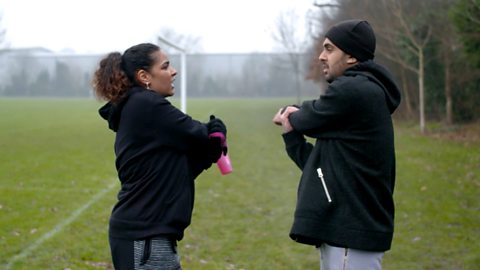Knowing the purpose of a text
Watch the video to find out more.
Speaker 1: Mobile phone offers, local newspapers.
Speaker 2: Can you see anything that looks like an electricity bill?
(TO AUDIENCE) You go away, you come home to loads of mail.
But every piece of writing has a different purpose and that makes sorting it easier.
Speaker 1: (TO OTHER PEOPLE) Hey, youÔÇÖve got two free hair gel samples.
Speaker 2: (TO AUDIENCE) Their purpose is to make me buy their hair gel.
Others might be about providing news, comments, criticism.
Speaker 1: (TO OTHER PEOPLE) These magazines are all about entertainment.
Speaker 2: (TO AUDIENCE) When you know the purpose of a piece of writing, itÔÇÖs easier to decide how to respond or if you even need to.
Speaker 1: (TO OTHER PEOPLE) IÔÇÖm going to put the oven on for dinner.
Speaker 2: (TO AUDIENCE) Whereas key words like 'overdue', 'final bill', 'payment needed now', means that weÔÇÖre late in paying our electricity bill.
Speaker 1: (TO OTHER PEOPLE) Oh! No electricity.
Speaker 2: (TO AUDIENCE) No dinner.
Speaker 1: (TO OTHER PEOPLE) There was a two-for-one pizza offer in there.
What is the right heading?
Test your knowledge with this activity.
How to scan and skim
Watch the video to find out more.
Speaker 1: (TO AUDIENCE) BethÔÇÖs meeting the boss at the health centre tomorrow to talk about a new job.
Speaker 2: (TO OTHER PEOPLE) Well, here it is: the entire history of the health centre.
Speaker 1: (TO AUDIENCE) SheÔÇÖs been asked to learn about their aims and values.
Speaker 2: (TO OTHER PEOPLE) LetÔÇÖs just do a quick scan of the brochures.
Speaker 1: (TO AUDIENCE) Sometimes when we read weÔÇÖre looking for specific information. This is when scanning becomes useful.
ItÔÇÖs a way of looking quickly through lots of information to find specific detail.
YouÔÇÖve probably done it already when youÔÇÖre looking something up in the dictionary.
And you can do the same online by scanning categories, and drop-down menus to find what youÔÇÖre looking for.
Speaker 2: (TO OTHER PEOPLE) About, aims and objectives.
Speaker 1: (TO AUDIENCE) Now sheÔÇÖs found the right bit, Beth can skim the text to get an idea of the aims and values.
Skimming is a great way to get the gist in time for tomorrowÔÇÖs meeting.
Scanning information for a specific detail, or skimming a piece of writing for a general idea of the contents, are great techniques of making reading and research easier.
(TO OTHER PEOPLE) So, aims and values sorted, yeah?
(TO AUDIENCE) SheÔÇÖs normally more of a morning person.
What is scanning and skimming?
Test your knowledge with this activity.
Find the meaning in a piece of writing
Watch the video to find out more.
Speaker 1: ItÔÇÖs official. WeÔÇÖre the worst team in the league. Check this out.
Speaker 2: (TO AUDIENCE) All writing conveys meaning.
But how can we tell if what weÔÇÖre reading is factual or someoneÔÇÖs opinion?
(TO OTHER PEOPLE) 'The lads have looked tired every time theyÔÇÖve run onto the pitch.'
(TO AUDIENCE) The words 'have looked' tell me that this is the writer's opinion.
Speaker 3: (TO OTHER PEOPLE) 'My 11-year-old son has more chance of getting the ball on target than this striker.'
Speaker 2: (TO AUDIENCE) That lineÔÇÖs meant to be funny, thereÔÇÖs a bit of exaggeration in there and itÔÇÖs very unlikely to be factual.
Speaker 3: (TO OTHER PEOPLE) This is a more factual analysis: 'WeÔÇÖve scored more goals so far this season than at this point in the last five years.'
Speaker 2: (TO AUDIENCE) This analysis is more reliable.
Evidence is given, figures are printed and the tone is more formal.
(TO OTHER PEOPLE) LetÔÇÖs see. 'Crowd attendance is up 23% on the previous season.'
(TO AUDIENCE) One writer is trying to stir up argument and debate.
The other is presenting information to give us more knowledge.
Both types of writing are important so long as we understand the difference in the writersÔÇÖ intentions.
(TO OTHER PEOPLE) So, you still coming to the match?
Speaker 1: Yeah, but we wonÔÇÖt win though.
Fact or opinion?
Test your knowledge with this activity.
More on Learn the basics
Find out more by working through a topic
- count7 of 10

- count8 of 10
